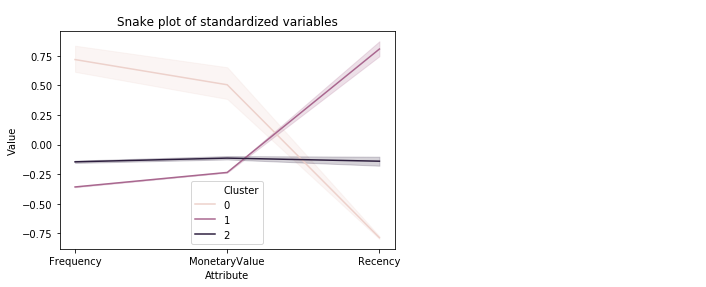Profile and interpret segments
Customer Segmentation in Python

Karolis Urbonas
Head of Data Science, Amazon
Approaches to build customer personas
- Summary statistics for each cluster e.g. average RFM values
- Snake plots (from market research)
- Relative importance of cluster attributes compared to population
Summary statistics of each cluster
- Run k-means segmentation for several k values around the recommended value.
Create a cluster label column in the original DataFrame:
datamart_rfm_k2 = datamart_rfm.assign(Cluster = cluster_labels)Calculate average RFM values and sizes for each cluster:
datamart_rfm_k2.groupby(['Cluster']).agg({ 'Recency': 'mean', 'Frequency': 'mean', 'MonetaryValue': ['mean', 'count'], }).round(0)- Repeat the same for k=3
Summary statistics of each cluster
- Compare average RFM values of each clustering solution
Snake plots to understand and compare segments
- Market research technique to compare different segments
- Visual representation of each segment's attributes
- Need to first normalize data (center & scale)
- Plot each cluster's average normalized values of each attribute
Prepare data for a snake plot
Transform datamart_normalized as DataFrame and add a Cluster column
datamart_normalized = pd.DataFrame(datamart_normalized,
index=datamart_rfm.index,
columns=datamart_rfm.columns)
datamart_normalized['Cluster'] = datamart_rfm_k3['Cluster']
Melt the data into a long format so RFM values and metric names are stored in 1 column each
datamart_melt = pd.melt(datamart_normalized.reset_index(),
id_vars=['CustomerID', 'Cluster'],
value_vars=['Recency', 'Frequency', 'MonetaryValue'],
var_name='Attribute',
value_name='Value')
Visualize a snake plot
plt.title('Snake plot of standardized variables')
sns.lineplot(x="Attribute", y="Value", hue='Cluster', data=datamart_melt)
Relative importance of segment attributes
- Useful technique to identify relative importance of each segment's attribute
- Calculate average values of each cluster
- Calculate average values of population
- Calculate importance score by dividing them and subtracting 1 (ensures 0 is returned when cluster average equals population average)
cluster_avg = datamart_rfm_k3.groupby(['Cluster']).mean()population_avg = datamart_rfm.mean()relative_imp = cluster_avg / population_avg - 1
Analyze and plot relative importance
- As a ratio moves away from 0, attribute importance for a segment (relative to total pop.) increases.
relative_imp.round(2)
Recency Frequency MonetaryValue
Cluster
0 -0.82 1.68 1.83
1 0.84 -0.84 -0.86
2 -0.15 -0.34 -0.42
# Plot heatmap
plt.figure(figsize=(8, 2))
plt.title('Relative importance of attributes')
sns.heatmap(data=relative_imp, annot=True, fmt='.2f', cmap='RdYlGn')
plt.show()
Relative importance heatmap

Recency Frequency MonetaryValue
Cluster
0 -0.82 1.68 1.83
1 0.84 -0.84 -0.86
2 -0.15 -0.34 -0.42
Your time to experiment with different customer profiling techniques!
Customer Segmentation in Python




